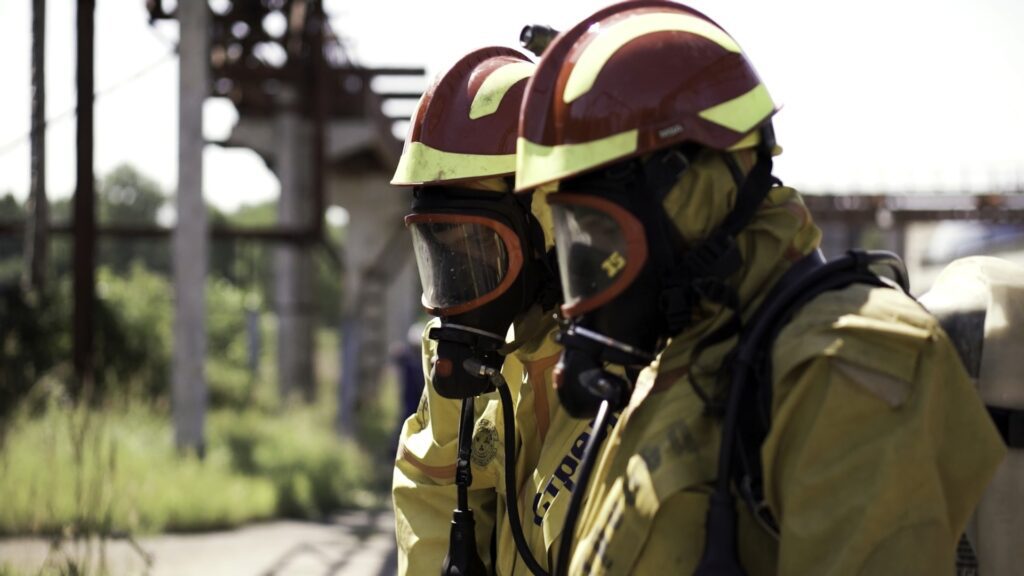
A full-face gas mask is a critical piece of safety equipment designed to protect individuals from various hazardous substances in emergency situations. These masks provide comprehensive coverage, shielding the eyes, nose, and mouth from harmful gases, chemicals, and particulates.
Chemical Spills
In the event of a chemical spill, whether in an industrial setting or on the road, a full face gas mask can prevent inhalation of toxic fumes and protect your eyes and face from exposure to corrosive substances.
Industrial Accidents
Manufacturing facilities and chemical plants may encounter accidents like leaks or explosions. Wearing a gas mask can help employees safely evacuate or mitigate the effects of harmful chemicals.
Radiological Incidents
In the aftermath of a radiological accident or nuclear disaster, a gas mask can be essential for minimizing the inhalation of radioactive dust and particles.
Riot Control
When participating in or near civil unrest, protests, or riots, a full-face gas mask can protect you from tear gas, pepper spray, and other crowd-control agents deployed by law enforcement.
Chemical Warfare
In military or security operations, soldiers may require full-face gas masks to protect against chemical, biological, radiological, and nuclear (CBRN) threats from enemy forces.
Hazardous Materials Transport
Truck drivers or emergency responders handling hazardous materials like toxic chemicals, gases, or radioactive materials should wear gas masks in the event of a spill or accident.
Biological Research
In laboratories working with infectious agents, toxins, or hazardous biological materials, researchers should wear gas masks to prevent accidental exposure to harmful substances.
Environmental Cleanup
Responders dealing with environmental disasters, such as oil spills or hazardous waste cleanup, may need gas masks to protect against toxic fumes and contaminants.
Search and Rescue Operations
First responders conducting search and rescue missions in areas affected by natural disasters like earthquakes, floods, or hurricanes may require gas masks to avoid inhaling hazardous dust, mold spores, or airborne contaminants.
Abandoned or Contaminated Buildings
When entering derelict or abandoned structures, especially those previously used for industrial or chemical storage, a full-face gas mask can protect against hidden dangers, such as noxious gases or mold.
Asbestos Removal
Workers involved in asbestos removal must wear gas masks to shield themselves from inhaling asbestos fibers, which can cause severe respiratory issues.
Volcanic Eruptions
In regions prone to volcanic eruptions, gas masks may be necessary to guard against volcanic ash and noxious gases emitted during an eruption.
Nuclear Power Plant Incidents
In the event of a nuclear power plant accident or meltdown, gas masks can provide a layer of protection against radioactive particles and contaminants in the air.

What to Know Before Purchasing a Gas Mask
Purchasing a full-face gas mask is a critical decision that requires careful consideration of several factors to ensure your safety and protection in emergency situations.
- Identify Your Specific Needs: Determine the primary purpose of the gas mask. Are you buying it for protection during chemical spills, biological emergencies, industrial work, or other situations? Different models and filters are designed for specific types of threats.
- Certifications and Standards: Look for gas masks that meet relevant certifications and standards, such as those established by organizations like the National Institute for Occupational Safety and Health (NIOSH) or the European Union (CE marking). These certifications ensure the mask’s effectiveness.
- Fit and Comfort: Ensure that the gas mask fits snugly and comfortably on your face. A good fit is crucial to prevent leakage and to provide adequate protection. Some masks come with adjustable straps and harnesses for a personalized fit.
- Visibility: Opt for a mask with a wide field of vision to ensure you have clear sight in emergency situations. Masks with anti-fog features and impact-resistant lenses are also advantageous.
- Filter Type: Choose the appropriate filter cartridges for your specific needs. Filters are typically labeled with letters to indicate the type of contaminants they protect against. Make sure you have the right combination of filters.
- Filter Lifespan: Be aware of the filter cartridge’s lifespan and replacement requirements. Some filters have a limited shelf life or can be used for a certain number of hours before replacement is necessary.
- Ease of Maintenance: Consider the ease of cleaning and maintaining the gas mask. Look for masks with removable components and clear instructions for cleaning and replacing parts.
- Durability and Material: Invest in a gas mask made from high-quality materials that can withstand the rigors of emergency situations. Masks with robust construction and durable rubber seals are preferable.
- Cost vs. Quality: While cost is a factor, prioritize quality and effectiveness over price. Saving money on a subpar gas mask may compromise your safety when it matters most.
- Reviews and Recommendations: Research and read reviews from reputable sources, and seek recommendations from professionals or experts in the field. Real-world user experiences can provide valuable insights into a mask’s performance.
- Training and Familiarity: Before using the gas mask in an emergency, undergo proper training to ensure you know how to don and doff it correctly, as well as how to change filters and perform maintenance.
- Storage and Shelf Life: Consider the shelf life and storage requirements of the mask and its filters. Proper storage is essential to ensure that the equipment remains effective over time.
Proper Storage to Ensure the Mask is Ready to Use in an Emergency
Storing and maintaining a full-face gas mask for emergencies is crucial to ensure its effectiveness when you need it most. Proper storage and maintenance can extend the life of your mask and help you stay prepared for various hazardous situations, especially if the gas mask may not be used for years.
- Remove the Filters: Remove the filter cartridges from the mask before storage. This prevents the filters from deteriorating prematurely and extends their lifespan.
- Inspect for Damage: Conduct a visual inspection of the mask for any signs of damage, wear, or deterioration. Check the facepiece, straps, valves, and other components. If you identify any issues, address them before storing the mask.
- Keep Spare Parts: These components can wear out over time, and having backups can ensure your mask remains functional.
- Maintain a Record: Maintain a log or record of when you last inspected and maintained your gas mask. Note any repairs, replacements, or filter changes to help you stay organized and on top of maintenance tasks.
- Perform Regular Inspections: Periodically inspect your gas mask, at least every few months, to ensure it remains in good working condition. Look for cracks, tears, loose straps, or damaged valves. Pay special attention to the mask’s airtight seal.
- Test the Seals: To test the mask’s airtight seal, perform a user seal check. Don the mask, exhale gently, and cover the filters with your hands. If the mask maintains a slight positive pressure and no air leaks out, the seal is likely intact.
- Replace Damaged Components: If you find any damaged or worn parts during your inspections, replace them immediately. Do not attempt to repair the mask with makeshift solutions, as this can compromise its effectiveness.
- Practice Donning and Doffing: Regularly practice putting on (donning) and taking off (doffing) the gas mask to ensure you can do it quickly and correctly in an emergency situation. Familiarity with the process is essential for effective use.
- Rotate Filters: If your gas mask uses multiple filters, rotate their usage to ensure even wear. This prevents one filter from becoming significantly more exhausted than the others.
- Stay Informed: Keep up-to-date with manufacturer recommendations and guidelines for maintenance and filter replacement. These guidelines may evolve based on new research and developments.
Buying the correct one, maintenance, and the use of appropriate filters are essential when relying on gas masks for protection in emergencies.



